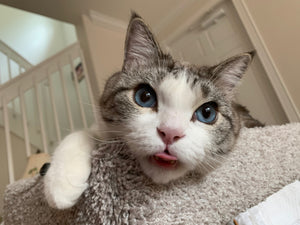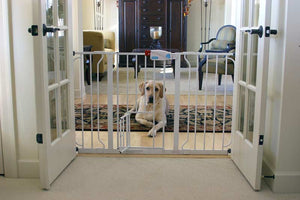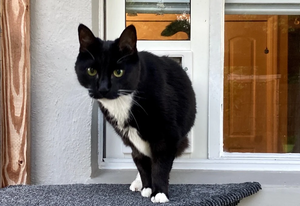How to Prevent Indoor Cats from Escaping
While some cats are content surveying the great outdoors from the safety of a cozy window perch, others are determined to experience it firsthand. Unfortunately, this means a lot of frustration and worry for any cat owner with an escape-artist kitty.
This article covers some tips & tricks for when your indoor cat keeps trying to escape, including:
- Why cats try to escape
- Preventative measures
- Safety precautions

Why Indoor Cats Try to Escape
Have you ever wondered, "why does my cat want to go outside?” Has your cat's escape attempts ever made you wonder "is my indoor cat happy?"
Don’t worry. It’s completely natural that your indoor cat wants to go outside. However, the outdoors poses a number of risks for cats, including busy streets and wild animals. Here are some reasons why a cat might try to escape:
Searching for prey:
Cats are natural hunters, so it’s not unusual for them to look outside for something to chase. If you have a cat in search of prey, escape attempts could become a common occurrence.
Assessing their environment:
Similar to their natural tendency to hunt, cats also like to assess their surrounding environment for mates or potential dangers. If your cat is not fixed, this tendency may be amplified, so we recommend spaying or neutering your cat.
Curiosity:
Plain-old curiosity is reason enough for a cat to try and explore what lies outside of the front door. Naturally, cats will want to know where you’re off to when they see you step outside, increasing the chance that they’ll follow suit.

How to Prevent Cats from Escaping
Understanding the reasons why your cat wants to escape is the first step towards learning how to keep a cat indoors. Below, we’ll discuss a few preventative measures that explain how to stop a cat from going outside.
Create Barriers:
If possible, try to block access to your cat’s preferred escape route. A tall indoor enclosure is a good option. While most cats will be able to jump over it, the walls will buy you some time to get through the front door before your cat can slip out behind you.
If your cat is escaping constantly, getting them spayed or neutered might be necessary. When a young cat suddenly wants to go outside, it could be because they are searching for a mate (this is particularly true for male cats). Once you rule this out, it’s time to start behavior training:
- Clap your hands when you see your cat clawing at the door to get out, making the doorway seem as unappealing as possible. Be sure to stop as soon as you see your cat walking away from the door and reward them with a treat.
- To keep your cat away from the door, try Motion-Activated Pet Deterrents—orange or lemon sprays work well, as most cats do not like the smell of citrus.
- Place some aluminum foil along the doorway area. Many cats find the feeling of walking on it unpleasant and will steer clear.
Distraction:
If you struggle with your cat slipping out behind you as you leave for the day, finding something to distract them is a great idea. Here are a few suggestions:
- When you leave your house, try guiding your cat away from the door with a laser pointer, or throwing a toy into another room to occupy them.
- Make staying inside more appealing with lots of treats, toys, and comfy hideaways in rooms far away from any exit points.
- Hang bird feeders next to a window perch so your cat can enjoy the excitement of the outdoors from the safety of your home.

Try a New Feeding Schedule:
Strategically adjusting your cat’s feeding schedule combines behavior training and distraction. Try feeding your cat as soon as you leave in the morning and right when you get home for the day. This distracts them as you step out the door and gives them an incentive to stick around for dinner when you get back home.
Allow Limited Outdoor Time:
If you’re comfortable with your cat having some outdoor time, letting them out for a few hours a day is a good way to reduce escape attempts.
- Try a harness and leash to safely take your cat outside. Make sure to take them out through one designated door that they can associate with outdoor time (to prevent them from dashing out every door they see).
- Any DIY-enthusiasts out there? Consider building a catio! A catio is a safe outdoor enclosure for cats that you can fill with cat trees and toys.
- If your home already has an outdoor screen enclosure, that can be a great place to let your cat explore.

Install a Cat Door
If you find that your cat escapes, but always comes back home a few hours later, it might be worth considering an indoor-outdoor lifestyle for them. Installing a cat door is a great way to allow your cat outdoor access at designated times.
Here are some of our recommendations:
CatMate Elite 305 Super Selective Cat Door:

The CatMate Elite Super Selective Cat Door is perfect for cat owners who want to control access to the door. It features timer control for up to nine cats for customizable entry and exit—perfect for keeping one cat in while letting another out. The LCD screen displays the location of up to three cats and the time that they entered or exited the house.
Teaching cats to use a cat door isn’t always easy! Once you’ve found the perfect cat door for your home, see how to train your cat to use a cat door.

Safety Precautions
In the event that your cat escapes, it’s important to be prepared with a few safety measures:
- Make sure your cat has a collar with their name and address. It’s also a good idea to get your cat microchipped just in case they lose their collar.
- Ensure they stay up to date with vaccinations and regular vet checkups.
- If you choose to let your cat outdoors, take a look at some springtime safety tips for outdoor pets.
We hope these tips helped explain how to keep your cat from escaping and how to safely allow them some outdoor time with a cat door. Show your feline friend some extra love today!





@Christine Berini and others that need to comfort their cats in unfamiliar environments: The author’s suggestions were good. I would also suggest putting a couple of the owner’s dirty socks in their cat bed or cat carrier — wherever they prefer to relax the most. Also play with the cat to make this place fun.
Hi Christine,
As you mentioned, it’s very likely that your brother’s cat is just trying to get home! A great option in this situation is to make your home feel as familiar as possible for your brother’s cat. A great way to do this is to fill your environment with all of his favorite toys, beds, and scratchers. Cats are scent-oriented creatures, so anything that smells like them (cozy beds, blankets, etc) will feel like home. Additionally, making the front door an undesirable place to hang out with some cat-safe deterrents like pet-friendly citrus spray or aluminum foil reduces the risk of escape. I hope this helped!
Happy holidays!
We have an indoor cat and will want to have the patio door open in the warm weather. Is there a screen we can put on the patio door so we can have fresh air coming in and for the cat not to go outside.
Hi, my cat seems to be waiting at the door whenever I get home from school, and he has escaped a few times, so we are having trouble with this. We have tried your suggestions for when my cat is going out the door with me, but can’t find anything for when he decides to slip out through the crack of the door when we come inside.
Thank you for your time in putting this together! I found it very useful and a safer way of doing things😊
Best Wishes!
I sit my brothers cat while he is in Florida. Do not want his cat to escape and he is determined. Figure he just wants to go home. What do I do?
Hi Norm,
Microchip pet doors are programmed to be usable with specific pets. However, there is still a chance that your cat could slip through the door with the dogs.
There are 4 way locking microchip pet doors, such as the https://www.petdoors.com/products/sureflap-microchip-pet-door
This means that it can be set to open out only, in only, unlocked, and locked. There is also curfew mode where you can set what times your pets can use the door.
If you have any additional questions, please feel free to contact us at customerservice@petdoors.com!
We want our two little dogs to go and comeback they a dog door, but how do we stop our new cat from exiting? It seems that all electronic m/chip door all exit but control who gets back in